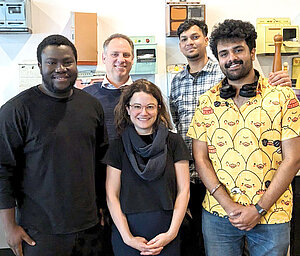NDSU researcher studying impact of jumping genes

Sarah Signor, an assistant professor of biological sciences at North Dakota State University, has received $1.81 million from the National Institutes of Health to study genes called transposons and their impact on evolution. Signor's research aims to understand how defense systems have evolved against these genes and their important implications for health and fertility in humans and other species.
Transposons, often called "jumping genes," can move to different positions within DNA. Similar to a small segment of text in a book that moves to different chapters and alters the overall story, a transposon's movement often changes how DNA functions by turning genes on or off or modifying their function. Transposons are found widely in plants and animals.
Maintaining DNA stability is crucial for health and fertility, but transposons disrupt this stability by inserting themselves into different parts of the genome. While this plays a role in evolution and genetic diversity, it can also cause mutations and genetic disorders.
Organisms use a defense system involving small RNA molecules to identify and silence transposable elements. Signor's research explores the evolution of RNA production and other transposon suppression methods. "While dedicated systems exist to stop the processes caused by transposons, new findings suggest other, less understood mechanisms might also be at play as transposons themselves evolve new methods of inserting their genetic material into DNA," she said. "The process of transposon activity and the resulting host suppression activities creates an arms race of sorts, and we want to understand how these defense systems evolve and vary across different organisms."
The research promises advances in fields such as population genetics and gene regulation and could have important implications for health and fertility in humans and other species.

Transposon activity was first discovered in 1944 by Barbara McClintock, a researcher at Cornell University who pioneered the study of cytogenetics using corn as a model organism. While McClintock's techniques are among some of the greatest contributions to science, it wasn't until the 1970s that their impact was better understood with the discovery of a type of transposon called P elements. Before the adoption of CRISPR technology, P elements were the primary method used by geneticists to modify and study genes.
Signor's work involves using the fruit fly Drosophila. P elements in Drosophila move within the genome and illustrate the disruptive power of transposons in living organisms. In extreme cases, their movement can result in high mutation rates, sterility, and other genetic issues.
Signor points out that transposon invasions in Drosophila used to be rare, occurring perhaps once every thousand years. "In the last 200 years, however, we've found 11 new transposons in Drosophila alone. This is extremely rapid change and could be a sign of human activity and its impact on Drosophila. Our work could help with understanding fertility issues and genetic stability while improving health outcomes."
Signor's lab features both graduate and undergraduate students. A proponent of undergraduate research opportunities, she often has more than a dozen undergrads participating in her lab, and one has been first author on a paper.
"Dr. Signor's work is an important and noteworthy example of the high-level life science research happening at NDSU today," said NDSU Vice President of Research and Creative Activity Colleen Fitzgerald. "Understanding issues such as infertility and genetic stability holds great promise in improving the lives of people everywhere."
Signor's work, "Co-evolutionary Dynamics Between Transposable Elements and Their Hosts," is supported by NIH award 1R35GM155272-01.


